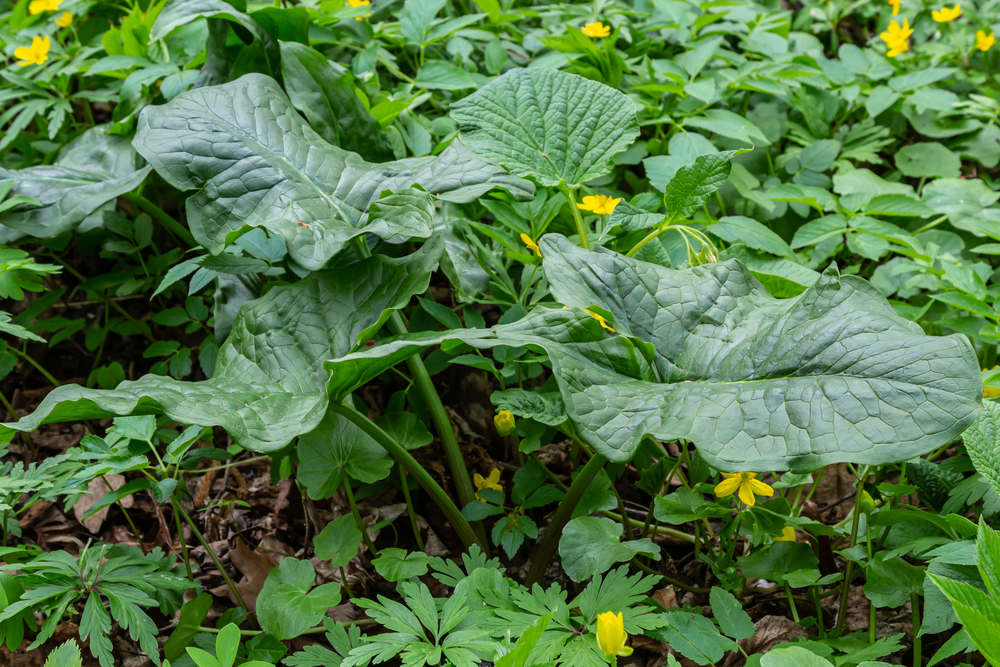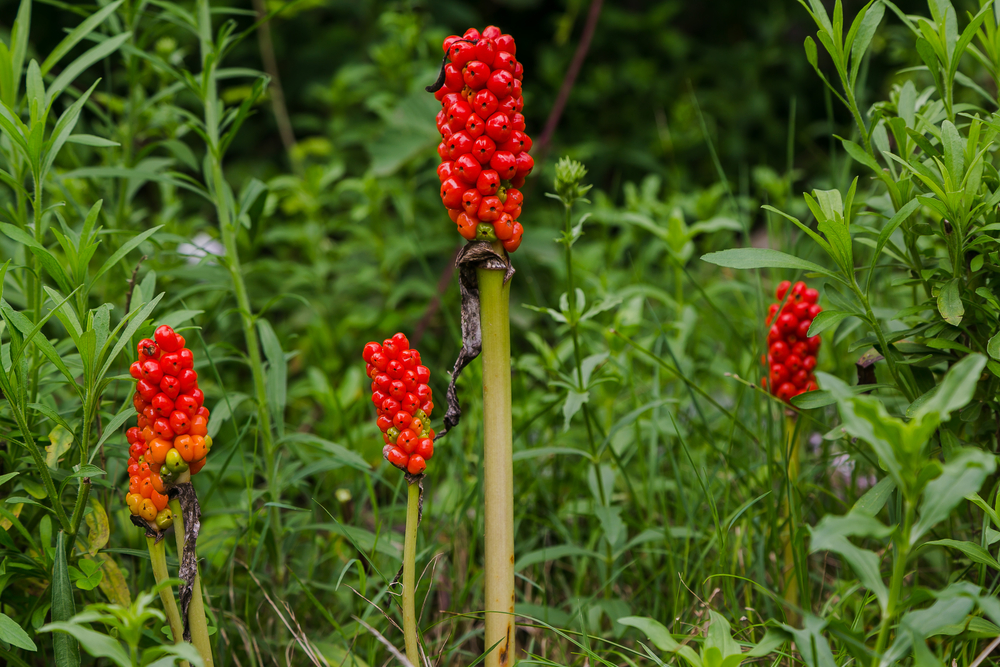The cuckoo pint plant (Arum maculatum) is a colourful, sometimes bizarre-looking flower that has spurred the imaginations of gardeners, naturalists and children for centuries.
Native to Europe and North Africa, this perennial of the Araceae family (of nearly 1000 species) can be a nuisance due to its poison and self-pollinating nature.
The cuckoo pint has been known by many names throughout history, including the lords and ladies plant, Adam’s needle, wild arum, arum lily, starch root, wake robin and adder’s root. Since the 1700’s, it has been known by up to 150 different names. Many are too lewd for this article, but mainly because of its resemblance to male and female genitalia.
How To Identify Cuckoo Pint
This perennial produces a large cluster of flowers on long thin stalks that extends up toward the sky. The flowers can be up to 4″ in diameter and are held up by a long, thin stem that is as tall as the plant. Cuckoopint flowers have a large leaf-like hood that extends out a short distance from the flower centre, which is usually hairy and covered in tiny hairs. The flowers are approximately 4-6 inches long, with long stamens (the male of split into two), and are often confused for male genitalia.
The young leaves look strikingly similar to wild garlic, and just to add to the confusion, arum maculatum will often grow near wild garlic. However, the two can be easily distinguished as the cuckoo pint plant doesn’t share the same pungent smell as garlic.
Once the berries appear, they will often be bright red, but sometimes can also be orange berries, all of which are poisonous.
On this plant, the stamens have a purplish black centre that makes them look similar to a pistil (female part). The seeds are produced in small clusters on the side of this plant which allows them to be spread by birds and other insects.

Where To Find Cuckoo Pint
The cuckoo pint is an understory plant, often growing along forest edges and in woodland gardens. The cuckoo pint grows best in shady areas or under a canopy of trees that provide plenty of moisture and shade. They prefer moist soil with a lot of organic matter and acidic pH levels.
Cuckoo pints are not picky about soil type as long as it is well-drained, but they do need to retain at least some moisture due to their epiphytic habit (they grow on other plants). They rarely survive temperatures below 4 degrees Celsius.

When To See Cuckoo Pint
Flowering lasts between March til June, and berries appear in the autumn. The plant produces the most flowers during the month of July. However, you’ll find tubers in the soil all year round.

How Poisonous Is Cuckoo Pint?
The cuckoo pint is a tropane alkaloid-containing plant. Tropane alkaloids are neurotoxic to humans and other animals.
There are several reports of poisoning due to ingestion of cuckoo pint. The most common symptoms reported after ingestion include dry mouth, nausea, vomiting, abdominal pain, hallucinations and convulsions. In rare cases, coma and death can follow. Symptoms usually resolve themselves without intervention except in severe cases; however, patients should be observed carefully for 48 hours to make sure symptoms do not worsen and become life-threatening, causing respiratory or cardiac arrest.
The toxic properties of this plant are due to the high levels of tropane alkaloid content found within its tissues. Ingestion of cuckoo pint is inadvisable and should be avoided by children and pets.

Is Cuckoo Pint Poisonous To Dogs?
Cats, dogs and horses are highly susceptible to the toxic effects of the cuckoo pint. The orange/red berries can be appealing to dogs and other pets; however, all parts of the plant are considered toxic. The leaves, and roots are especially dangerous. The root contains more than twice as much poison as that found in the leaves.
Ingesting any part of this plant can be fatal if enough is ingested in a single dose, so it is not a good idea to grow it where pets or small children have access to it. The amount of plant material that would be required to kill a small child or dog is very low, which makes it easy for an animal to ingest a lethal dose accidentally.
Additional Resources
Sources and References
- Lords & Ladies – Arum maculatum – brickfieldspark.org
- Wildplant Of The Week “Cuckoo Pint” – bushgear.co.uk
Sam loves to learn about animals and their habitats. He has been a nature lover from a very young age, and has been writing papers and articles about wildlife for as long as he can remember.

I am impressed by striking, nay, beautiful appearance of a fruit-topped arum maculatum (cuckoo pint) that I have just come across for the first time in my long life. Equally so by the deadly attributes of which this website kindly informs me.
I am not going to stamp on it, but I hope it disintegrates before I think of someone whom…
Me thinks I had better not continue.
Ah, the beguiling beauty of the arum maculatum – it’s like nature’s fine print, isn’t it? Alluring on the surface, yet with a clandestine clause hidden within. But fear not, for your restraint in both footwork and thought is commendable! Indeed, one must tread lightly around such charm with caution.